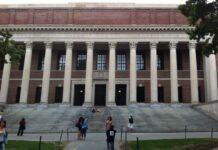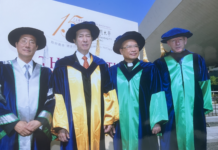IRRODL is now requesting contributions for peer review and possible publication in an upcoming special issue.
Emergent Learning, Connections, and Design for Learning
Editors: Roderick Sims, PhD and Elena Kays, PhD
Rationale
Connections? Emergence? Chaos? Complexity? Fractals? Quantum Theory? Although many of these terms originated and have been widely studied in the natural sciences, they are emerging as important interdisciplinary ways to understand both natural and social sciences, including education. The question therefore arises … are the traditions of what it means to teach and learn being challenged by these concepts, or are we simply experiencing the natural evolution of education through a process of emergence?
- Emergence encourages random encounters, paying attention to your neighbours, and “more being different”. Through such encounters and interactions we can look for patterns in the signs which can be extrapolated to an entire system, the intelligence of which comes from the bottom up, and where low-level rules can create high levels of sophistication.
- The connections being made between people through social networks has emphasised “connectivism”, an emergent theory of learning where the interactions that are generated by these connections, whether informal or formal, have the potential to result in new, emergent knowledge.
- For designers, taking account of emergence and connections can challenge the traditional models which have been used to create ‘instructional order’. Emergence theory offers insights into complex adaptive systems that can self-organize, a quite different way of conceptualising the teaching/learning space.
Given this link between connections and emergence, and the significant impact this association would have on how we teach and learn, it is therefore important to analyse what it means to design for emergent, connected learning experiences.
Special Issue
The purpose of this special issue of IRRODL is to provide a forum to explore connections, emergence and design for learning, and in so doing be sensitive to emergent ideas. Because we’ve designed and implemented education in one way for decades does not mean it’s the right way!
We encourage your ideas for topics, with the following list (by no means exclusive) identifying possible topics to be covered in this special issue.
• Methods for studying emergence in distributed , online contexts
• Extensive literature reviews of emergence and related disciplines focusing on their significance for education
• Empirical studies on extent and impact of emergence in learning contexts
• Emergence and social networks
• Connections and emergence – is ‘design’ realistic?
• Designs for learning in connected worlds
• Connecting affordances – virtual worlds, networks, social media
• Open Educational Resources and Emergent Learning
Submissions, especially those that apply multi-disciplinary approaches to online and distance teaching and learning, are welcomed for this edition.
Articles due: May 27, 2011
Editorial decision: September, 2011
Publication: November, 2011
Authors submit their manuscripts online by registering with IRRODL then logging in and following an automated, five-step submission process.
For more details see http://www.irrodl.org/index.php/irrodl/announcement/view/7










 Dr. Tony Bates is the author of eleven books in the field of online learning and distance education. He has provided consulting services specializing in training in the planning and management of online learning and distance education, working with over 40 organizations in 25 countries. Tony is a Research Associate with Contact North | Contact Nord, Ontario’s Distance Education & Training Network.
Dr. Tony Bates is the author of eleven books in the field of online learning and distance education. He has provided consulting services specializing in training in the planning and management of online learning and distance education, working with over 40 organizations in 25 countries. Tony is a Research Associate with Contact North | Contact Nord, Ontario’s Distance Education & Training Network.


[…] Tony Bates has a new post announcing a call for papers on “emergent learning.” The call does mention open educational resources. This entry was posted in Open Education and tagged online learning, open content, open course, Open Education, openness. Bookmark the permalink. ← SPARC OA April Newsletter LikeBe the first to like this post. […]
The social networks (facebook, myspace, twitter, etc.) are on a very high level of connectivism. But what does this have to do following the future? This connectivism can last a hundred years, or only ten years. We need to find a way to globally, as a whole, connect to each other in new certain emergent ways, but I see that technology is not available yet. We will see what occurs. Nice post.
I do not like Open university, OER .
These are repulsive words.
People would like to graduate with a degree from an accredited university or college. Right.
And the capacity and money of the existing accredited universities and colleges are limited. Right.
So here is a solution to increase your capacity 100 % within 5 years. 20 % each year.
1.- Adopt ONLINE full semester length with full learning material, homeworks, midterms, final and all solution plus video recorded in the real class of MIT, Harvard, Princeton, Yale, Stanford and many more
to your degree program.
2.- Assign a facilitator or online instructor ( Costs you only 25 % of the professor ) to the course.
3.- He manages all course , gives finals and grades
4.- The university counts these credits toward a degree.
5.- For each 10 online courses you adapt to your university you have a room for 1 new full time student f2f .
So if you take 100 online courses you create space for 10 students, if you take 1.000 online courses then 100
new students, if you take 10.000 courses then 1.000 new students .
Start right now :
Click
http://www.globalonlineuniversitiesconsortium.org
and adopt one of the 3.000 full semester length online course all free.
This is the gift of academicearth.org + MITOCW + freevideolearning
Benefits :
1.- Existing university does need any investment to increase its capacity
2.- University gets online courses from the best ivy league universities in the world
3.- It is all free. University saves millions of $
4.- Students can be hired faster since they courses from Harvard MIT Stanford
5.- Resources are not wasted.
6.- Same model works for all universities in the world .
mgozaydin@hotmail.com
Dear Tony BATES :
Business model is here.